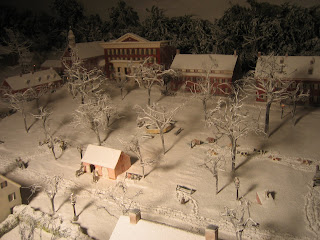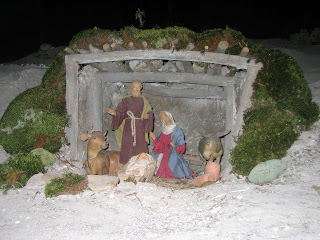
The Moravian Christmas Candle Tea for 2010 concluded last weekend. A tradition in Salem, North Carolina since 1929, Candle Tea is sponsored by the Women's Fellowship of Home Moravian Church. For two weekends following Thanksgiving every year, the women of the church transform the historic Single Brothers' House into a seasonal, sensory delight. Visitors move through different rooms of the Brothers' House and experience much-loved and uniquely Moravian Christmas traditions.
 Men, women, and children volunteers, outfitted in eighteenth-century Moravian dress, lead thousands of people through Candle Tea every year. Depending on the day, time, and weather, you might stand in line up to two hours before entering the Single Brothers' House for Candle Tea. Here is an oppportunity for you to get a virtual peek at Candle Tea, with no wait in line.
Men, women, and children volunteers, outfitted in eighteenth-century Moravian dress, lead thousands of people through Candle Tea every year. Depending on the day, time, and weather, you might stand in line up to two hours before entering the Single Brothers' House for Candle Tea. Here is an oppportunity for you to get a virtual peek at Candle Tea, with no wait in line. When you enter the building, you are first ushered into the Ante Room, where a hostess will tell you a bit of history about the single brothers and this house where they lived in while learning their trades.

After singing carols, you are escorted downstairs to watch a demonstration of beeswax candles being made, in what was the dining room for the single brothers. Moravians have used candles in Christmas Eve services dating back to 1747 - a time when Christmas Eve services were almost unheard of. These handmade candles, with their distinctive red crepe paper ruffs, are used at Christmas Eve services throughout the Moravian Church, and they are often seen in non-Moravian congregations as well.
When you have finished your cake and coffee, you proceed downstairs once again, this time to the sub-basement of the building.  This is where the single brothers stored their food; it is cold and dark, the walls are over a foot thick, and the floors are large slabs of stone.
This is where the single brothers stored their food; it is cold and dark, the walls are over a foot thick, and the floors are large slabs of stone.
 This is where the single brothers stored their food; it is cold and dark, the walls are over a foot thick, and the floors are large slabs of stone.
This is where the single brothers stored their food; it is cold and dark, the walls are over a foot thick, and the floors are large slabs of stone. The sub-basement is where visitors see the putz, which is a German tradition of creating a miniature scene. The first room you come to features the Salem Scene: a miniature replication of the village of Salem, circa 1900. The scene is over thirty feet long, and eight feet wide.
The sub-basement is where visitors see the putz, which is a German tradition of creating a miniature scene. The first room you come to features the Salem Scene: a miniature replication of the village of Salem, circa 1900. The scene is over thirty feet long, and eight feet wide.  The village is built on HO-scale. All of the structures are handmade by volunteers in the church. The buildings are made of balsa wood and art poster board, and each one is handpainted to reflect the actual structures of Salem, even down to the number of slats on the sides of the buildings. The oldest buildings were built in 1949. In October of each year, a group of volunteers unpack and re-create the scene; every bit of the scene is packed up and stored after Christmas.
The village is built on HO-scale. All of the structures are handmade by volunteers in the church. The buildings are made of balsa wood and art poster board, and each one is handpainted to reflect the actual structures of Salem, even down to the number of slats on the sides of the buildings. The oldest buildings were built in 1949. In October of each year, a group of volunteers unpack and re-create the scene; every bit of the scene is packed up and stored after Christmas.
The second room in the sub-basement, and the last room you will visit in Candle Tea, features the Nativity Scene. Different scenes of the birth narrative from Luke are displayed in a cave-like setting (again, a food-storage area for the brothers), and the overall effect of a grotto on a cold winter night is very effective. The wooden figures in this scene were made in Oberammergau, Germany, over fifty years ago.









No comments:
Post a Comment